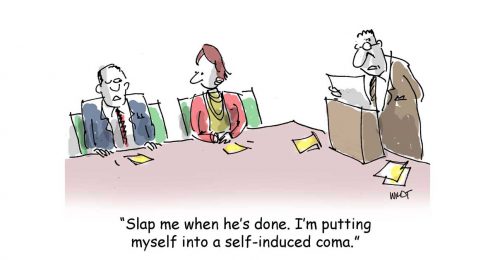A few weeks back, I got an email from a striving director.
My organization is struggling. I’m making calls every single month to hold at least one vendor at bay or to negotiate a way to pay some of the bills that have piled up. Our development director just resigned for a better-paying position with another organization. I’m upset about it for sure, but I’m also conflicted. After all, at least now we’ll save money on that salary…
She told me she had been here before and somehow managed her way through. She actually didn’t seem burned out. In fact, her question was “How many times do we dig out of the ditch before we should really call the question?”
In case you’re wondering, “the question” is: When is the right time to dissolve a nonprofit?
A few board members she respected thought maybe now was time; most of the others just assumed the E.D. would pull yet another rabbit out of the hat…
In many cases like this, the question is called when there isn’t enough money. Yep, it becomes all about the almighty dollar sign.
As a result, the executive director spends a great deal of time focusing on money and asking board members to do more — which leads to a whole lot of tension and uncertainty.
And because you spend so much time talking about money, conversations about non-financial success and impact start to take a back seat. Now all of a sudden your board begins to feel that the organization’s impact does not always feel big enough to warrant the infrastructure investment.
And so how do you know? How can you possibly abandon the work? The clients?
Believe it or not, this is EXACTLY the time in the lifespan of your organization when you DO NOT throw in the towel and dissolve your nonprofit.
It’s actually the time you most need to dig deep, get strategic, ask tough questions, and be creative — and this post will help you have that kind of conversation with your board leaders and senior staff.
So if the drumbeats of “maybe we should close shop” are getting louder, keep on reading. Following these steps will help you make a smart well-informed decision that puts your mission first — regardless of the choice you make.
There is too much riding on this. The folks you serve deserve nothing less.
The recipe demands that you all agree to spend a half-day together digging in and addressing this big hairy question wisely. It should be a high-level, generative meeting. And you need to set aside any issues of financial scarcity. Circulating financial statements or trends year-over-year tells only a part of the story and cannot drive your decision.
BEFORE THE BIG MEETING
Two essential pieces of pre-work must be done and must be shared with your board and senior staff before you discuss whether it’s time to dissolve your nonprofit organization.
- The Origin StoryIs there a founder to track down? Are there materials that make the case for the founding of the organization? I’m looking for you to circulate the story that ignited the formation of your organization in the first place. The case that was made. The problem that was identified that your organization was launched to address. What problem was this organization created to solve? An interview, materials — go back to the very beginning. There are treasures in the origin story of an organization and you need to start there.
- A Landscape AnalysisThis will require a bit more work — it might even warrant a board/staff working group. Using the origin story as a north star, take a look at other organizations in your sector. What has transpired since the organization started? Are other, bigger organizations engaged in similar work? Complementary? For your half-day, this information is essential.
THE MEETING ITSELF
For the best results, it’s a good idea to have a facilitator join in to lead the meeting. This should be someone without a deep emotional investment in any possible outcome. And yet someone who does care about the work you do. If you can’t afford to hire one, identify someone impartial — an honest broker.
Once you’ve found your facilitator, there are five key steps you and your team need to take:
- Kick off the meeting by addressing this question: What has changed since the organization and what has remained the same? Using the pre-materials, you should be able to get a well-informed conversation going.
- Focus on the here and now. Answer this question: If your organization closed down tomorrow, what gap would there be and who would fill it? Is there another organization ideally suited to absorb your programs? Or get even more honest, are your programs resulting in the kind of impact you aspired to have? Were there faulty assumptions in the origin story?
- In this part of the conversation, it’s time to address the money issue. Would money make a difference? In other words, if you received a game-changing major gift, could you deliver on the promise of the origin story?
- Assess the footprint of your organization. Has it grown? Have you been successful in building an exponentially larger posse of folks who know about your work? More folks you serve? Remember: People = Power.
Let’s say you’re 10 years into the lifespan of your organization — is the posse a modestly expanded version of the folks who gave the organization life? Or are there exponentially more folks involved? More press? More volunteers? You need to build and grow an army. Assess how far you have come (or haven’t).Can your organization have a greater impact if your organization took a different form? A merger? Remember, a merger typically assumes that both entities are strong. If you are in this level of conversation, you are more likely to be an acquisition target.
The key here is ‘greater impact’ — not simply ‘salvaging’ or working to ‘hang on.’ Before you dissolve your nonprofit, is there another model that could lead to greater impact?
BUILD A WORKING GROUP
By the time you’ve gone through the five steps, you will probably have surfaced more questions than answers. Before ending the meeting, take some time to summarize them and review the items you have alignment around. Then put a working group in place made of board and staff and maybe even someone who’s not a part of either. It could even be someone who has been down this road before with another nonprofit or even someone with some Mergers and Acquisitions background.
This group also needs to design a communications plan. You’ll need confidentiality while you explore and your staff and board will need to agree to guardrails until there is some conclusion reached or forward motion that will demand that more people be in the loop.
WHAT YOU MAY LEARN
After you do the pre-work, you may walk into this meeting more confident than ever that this organization must be a standalone… that it fills a unique gap but that the organization is not currently strong enough — your organization is not thriving. Maybe you don’t have the right folks on the board, or maybe the funding model needs to be revisited.
Or maybe a deep dive will unearth a logical flaw in the origin story — that the right problem has been identified but that there may be a different way to approach it. This could lead you to shift how you think about your programs — maybe you will close one and determine that a different program is needed.
TAKE A DEEP BREATH
So maybe you see yourself in the executive director who emailed me. If you do, I am asking you please don’t just focus on the cash flow. Take a deep breath, share this post with your board chair, and have a really good conversation about how to have the deep conversation I have suggested. Plan it soon because you don’t want to make big decisions under really serious pressure.
Maybe you are thinking — “We’re not there yet. We can get through this rough patch…”
You might be right. I hope you are. That said, rough patches are usually symptomatic of something and you owe it to yourself and to those you serve to follow this recipe, dig deep, really assess the root causes of the rough patch, and then make some strategic decisions to set yourself on the right course to the highest impact.
If you want to get a jump start on this strategic work before your big meeting, join this free online training to learn five practical and actionable steps that will help your organization weather any storm.
In the training, I also uncover the number one fundamental mistake leaders make that can make running a nonprofit SO much tougher than it needs to be…
So click here if you are ready to build more resiliency, strengthen your org for the future, and become the best leader you can be.
Want to learn from a growing community of nonprofit leaders and get exclusive access to content from a variety of experts? Click here to learn more about the Nonprofit Leadership Lab.



